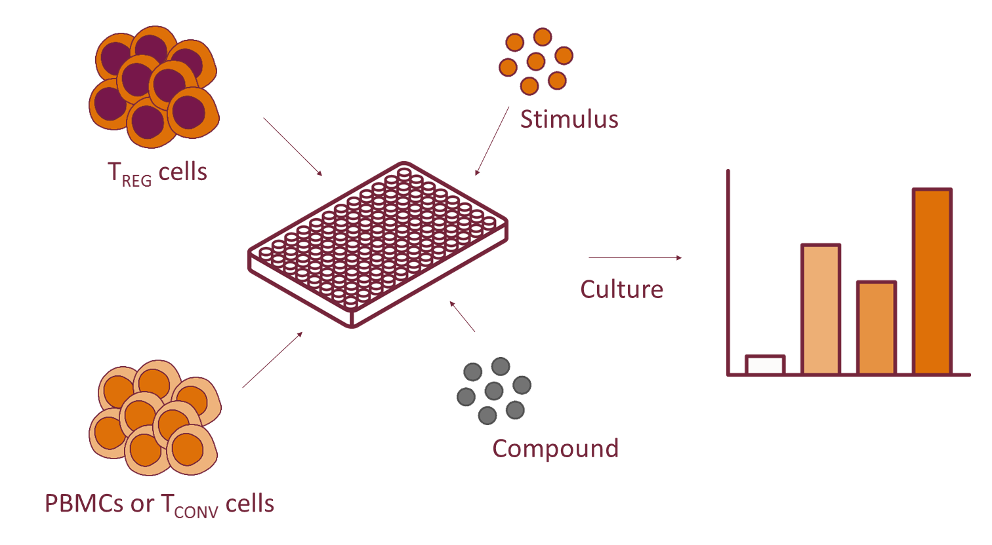
Regulatory T cell suppression assay
To achieve a balance between autoimmunity and immune escape, regulation of immune responses is paramount. One of the important players in regulating adaptive immune responses are regulatory T cells (TREG). Determining whether your compound of interest impacts TREG function is important to determine possible (off-target) effects and subsequent (unwanted) altered immune suppression.
This assay will give insight into the capacity of TREG cells to suppress activation of conventional T(TCONV) cells. TREG cells are part of the CD4+ T cell population and play a very important role in autoimmunity (suboptimal suppression of TCONV cells) and oncology (excessive suppression of TCONV cells). This assay could, for example, be of interest to you if you want to test (immunomodulatory) drugs that influence TREG-mediated suppression of conventional T cells.
 In order to induce suppression, TREG cells and TCONV cells are co-cultured in different ratios and a stimulus is added to activate both T cell populations. Proliferation of the TCONV population is then analyzed as a read-out to assess the extent to which the TREG cells are able to suppress activation of the TCONV cells. The assay is customizable in many ways. Total PBMCs can be used as a source of TCONV cells to closely mimic the in vivo situation. Alternatively, specific TCONV subsets (e.g. CD8+ TCONV) can be isolated and co-cultured with the TREG cells. Cells can be stimulated polyclonally, using T cell receptor and CD28 co-receptor crosslinking antibodies, or cells can be stimulated in an antigen-specific fashion. Furthermore, proliferation can be monitored over a longer period of time using a proliferation dye, or during a fixed time window, using radioactive thymidine incorporation. The assay is also easily combinable with cytokine and/or transcription factor analysis via flow cytometry.
In order to induce suppression, TREG cells and TCONV cells are co-cultured in different ratios and a stimulus is added to activate both T cell populations. Proliferation of the TCONV population is then analyzed as a read-out to assess the extent to which the TREG cells are able to suppress activation of the TCONV cells. The assay is customizable in many ways. Total PBMCs can be used as a source of TCONV cells to closely mimic the in vivo situation. Alternatively, specific TCONV subsets (e.g. CD8+ TCONV) can be isolated and co-cultured with the TREG cells. Cells can be stimulated polyclonally, using T cell receptor and CD28 co-receptor crosslinking antibodies, or cells can be stimulated in an antigen-specific fashion. Furthermore, proliferation can be monitored over a longer period of time using a proliferation dye, or during a fixed time window, using radioactive thymidine incorporation. The assay is also easily combinable with cytokine and/or transcription factor analysis via flow cytometry.
Of note, to obtain sufficient TREG cells to perform suppression assays or other functional assays with TREG cells, ex vivo expansion may be needed. We can provide the isolation of TREG cells and subsequent expansion without losing functionality.
Example of how our suppression assay can contribute to your TREG-related project
TREG suppression of CD4+ and CD8+ TCONV cells

Total PBMCs were co-cultured with different ratios of TREG cells and stimulated polyclonally using anti-CD3 and anti-CD28 antibodies. Proliferation was monitored using a violet proliferation dye, and staining for CD4 and CD8 allowed for individual assessment of the suppressive effects on the CD4+ and the CD8+ TCONV populations. % suppression for both populations is depicted relative to the level of proliferation without addition of TREG cells. As shown, the suppressive effect diminishes when less TREG cells are added to the culture.

